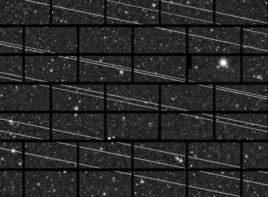Stars and galaxies may have formed much sooner after the big bang than astronomers previously thought, according to new observations by a German–US collaboration. The team detected iron in three of the most remote known quasars, which suggests that stars must have formed when the universe was just 200 million years old. Meanwhile, the most comprehensive survey yet of the abundance of elements in a distant galaxy could revolutionize our understanding of the synthesis of elements in stars.
Astronomers believe that virtually all elements heavier than boron are produced by nuclear reactions inside stars. When these stars explode at the ends of their lives, the elements are ejected into space. But before this can happen, the lighter elements created during the big bang – such as hydrogen and helium – must coalesce into stars, which must evolve for around 700 million years according to existing theories. This means that the presence of heavy elements in ancient stars and galaxies can indicate when star formation began.
Wolfram Freudling of the Space Telescope European Coordinating Facility and the European Southern Observatory in Germany and colleagues used the Hubble Space Telescope to inspect the light emitted by the three quasars (W Freudling et al 2003 Astrophys. J. Lett. 587 L67). As this light travelled through space, the expansion of the universe increased its wavelength – the effect known as ‘redshift’ – so the researchers detected it as infrared radiation. With redshifts ranging from 5.78 to 6.28, the light from these quasars must have been emitted just 900 million years after the Big Bang.
In the infrared spectra from the quasars, Freudling’s team found the characteristic absorption pattern of iron. If such a heavy element existed 900 million years ago, the researchers argue, stars must have started to form when the universe was around 200 million years old. “We believe that the iron we detected was created in the very first generation of stars which formed soon after the Big Bang,” says Freudling.
The discovery by Freudling’s group seems to be supported by a separate study by Jason Prochaska of the University of California at Santa Cruz and colleagues (J Prochaska et al 2003 Nature 423 57). Prochaska’s team used the HIRES spectrograph at the Keck I telescope in Hawaii to measure the abundances of 25 elements in a galaxy with a redshift of 2.63. Previous studies of this kind have focused on just a few relatively light elements.
The US researchers say that their discovery of heavy elements such as zinc in such a young galaxy suggests that stars may form and begin to synthesize elements much more rapidly than astronomers thought. They also found that the relative abundance of the 25 elements in the galaxy was similar to that in our – much younger – solar system. This could mean that the synthesis of elements has followed a common pattern throughout the history of the universe.



